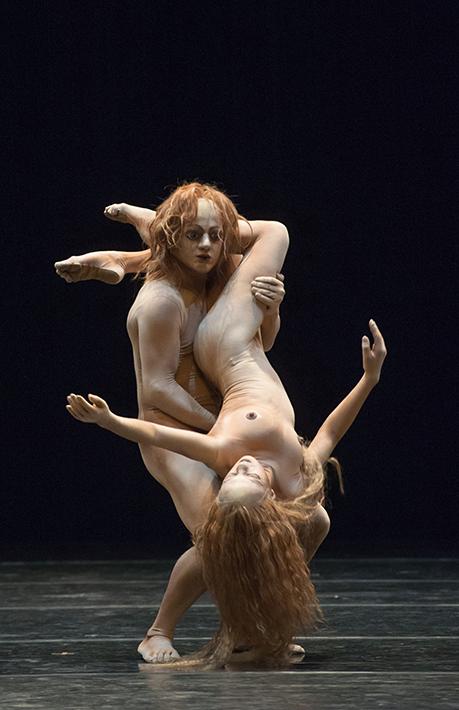
Two bodies, looking naked, advance on the stage, clasp one another and never let go for fifteen minutes. A man and a woman whose bodies attract and latch on to each other. Bonded to each other to become inseparable. She is a vine that coils, that furls. He keeps holding her, he holds her back, he holds her up. There is something mythical about their dance. In this total fusion of two beings that become one to never come apart again. Eden is the original love, in the time of innocence. There is also something raw, in this duo. The image of the sounds of waterfalls and thunderstorms that compose the dance sound. Eden is a dance full of force and beauty. Perhaps, because of the sense of nature released from the movement of purity and the precision of gesture, from the quasi sculptural figures, from the power of the bodies. That is where the emotion comes from. From this sobriety that reveals the essential. Yes, love is a dance, most certainly it is Eden.
Yasmine Tigoe

Composer Dan Kinzelman and choreographer Daniele Ninarello meet for the first time on a common ground for exploration: space as a place in which to exercise and transfigure the physical and sonic body, its transience, its impermanence, the struggle to resist.
Dan Kinzelman improvises live with electronics, mixing synthesis, the inner noise of machines and feedback, along with sounds generated by the instruments that he has used most often over the years: sax, clarinet, flutes, stratifying the various elements using a loop station.
In composing the choreographic part, Daniele Ninarello not only explores his familiar field of instant composition, but works within a territory created by the continuous dialogue with the soundscape and the information he receives from it, to contact the invisible threads that bind body and space. The experimentation with sound and with the body thus tends to translate the perceptive elements that make the evolution of the human figure visible. Something inside the body vibrates ceaselessly like a threat: it is chaos, the inner noise of scars and thoughts. And this is true for everyone. Only dance can gradually bring these traces into the here and now. And wipe the gaze clean, find peace. Like a true physical mantra to explore in its continuity: the mute perimeter of properly unshackled thought.
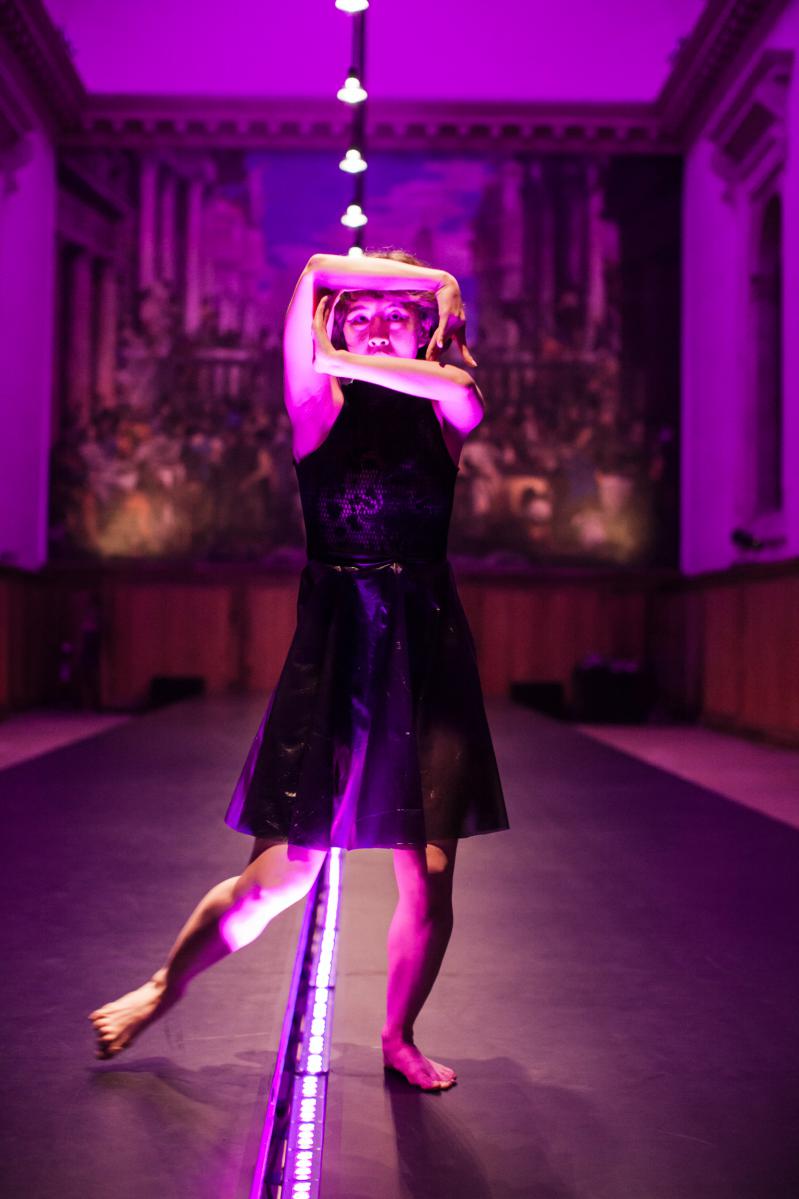
Outlander is a choreography created for the Cenacolo Palladiano of the Fondazione Giorgio Cini, a space embellished by Veronese’s large painting of the Wedding at Cana on its end wall. Shobana Jeyasingh, one of the most authoritative exponents of English contemporary dance, created this site specific work as a counterpoint to the famous Palladian site. The contrasting elements in the choreography also arise out of the dialogue with the space. They are a response and a tribute to the place and its extraordinarily dense network of lines, rhythms, colours and figures, within which the dancers inscribe their dance. «It’s like a game of tennis, you can only return what you receive», says the choreographer.
Shobana Jeyasingh identified three main places in the Cenacolo Palladiano of the Fondazione Giorgio Cini in which to weave her choreographic counterpoint: Palladio’s elegant and sober architectural design; then, almost in contrast with it, Veronese’s exuberant painting, full of gestures and human presence; and, within the painting itself, the figure of Christ: «a place of quiet neutrality beyond any schema or behaviour».
Vito Di Bernardi
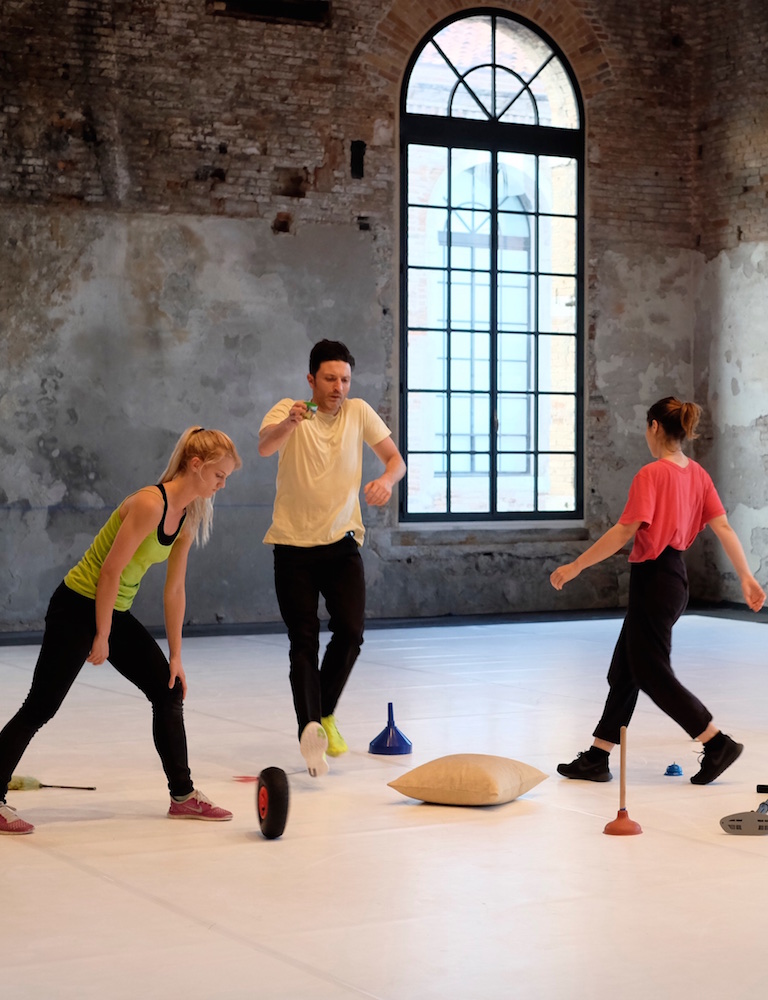
During her research experience at the P.A.R.T.S. Academy, Camilla Monga presented Quartetto per oggetti, a project that began with the participation of the dancers of Training Cycle, and the artistic collaboration of Jacopo Jenna and Luca Scapellato. The quartet reinterpreted Edgard Varèse’s concept for the composition of Ionisation by using objects that become the primary means for defining a series of physical possibilities. Camilla Monga uses the same logic to recreate a new version of the quartet adapted for the spaces of the Biennale. In Venice, the performance is entitled 13 Objects and features a polyrhythmic structure influenced by the physical properties of everyday objects. Their functions determine actions with unpredictable directional components that serve as a basis for expanding and varying the rhythm. The result is an intense paroxysmal vision that achieves an illusionary chaos and a surreal logic.

This is not a flamenco piece.
In OneTwoThreeOneTwo, a pair of male dancers use their bodies and their voices to ask, what is flamenco? How does this unwritten language – at once a music and a dance – create such intense, immediate communication?
Flamenco is an ancient, but living form. From the deepest roots of gypsy music to the grand stage productions of today, its power springs from the same fundamental rhythmical sequences: 123 123 12 12 12. The intimacy and audience involvment in the flamenco tablao generates a complex web of meaning, expression and storytelling – a unique set of rituals and techniques that continue to grow and evolve.
OneTwoThreeOneTwo breaks flamenco apart, examining each aspect of its singular magic.
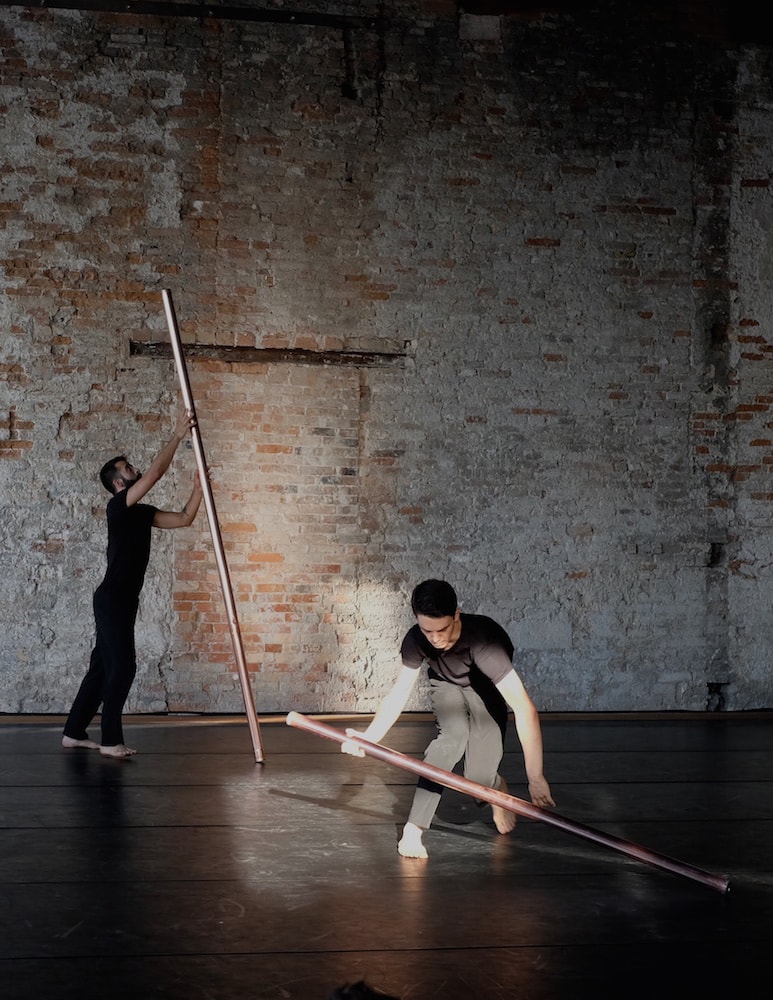
The stage is inhabited by three male performers. Each of them holds a rod made of copper. A durable material, cold to the touch and apparently lifeless, it appears in its potential to be branded. By dropping, suspending and assembling these three elements the space is transformed along with their bodies, constantly in search of new strategies for collaboration. What to build, a question inherent to dance itself where the desire for it drives experimentation. It can prove to be the greatest achievement or the greatest failure; building becomes a pretext for the three to begin a dialogue based on responsibility and acceptance. The touch allows for hesitation and pauses in which to come towards and experience a landscape. In this work Lara Russo continues to question the conviviality of material and of man, alone and in communion; the potential and poetics of collective intelligence. The collaboration with French artist Mahatsanga le Dantec becomes an opportunity for research into the geometries of bodies, the potential of material and sound, to develop a vision of the stage suspended between archetypes and new identities.
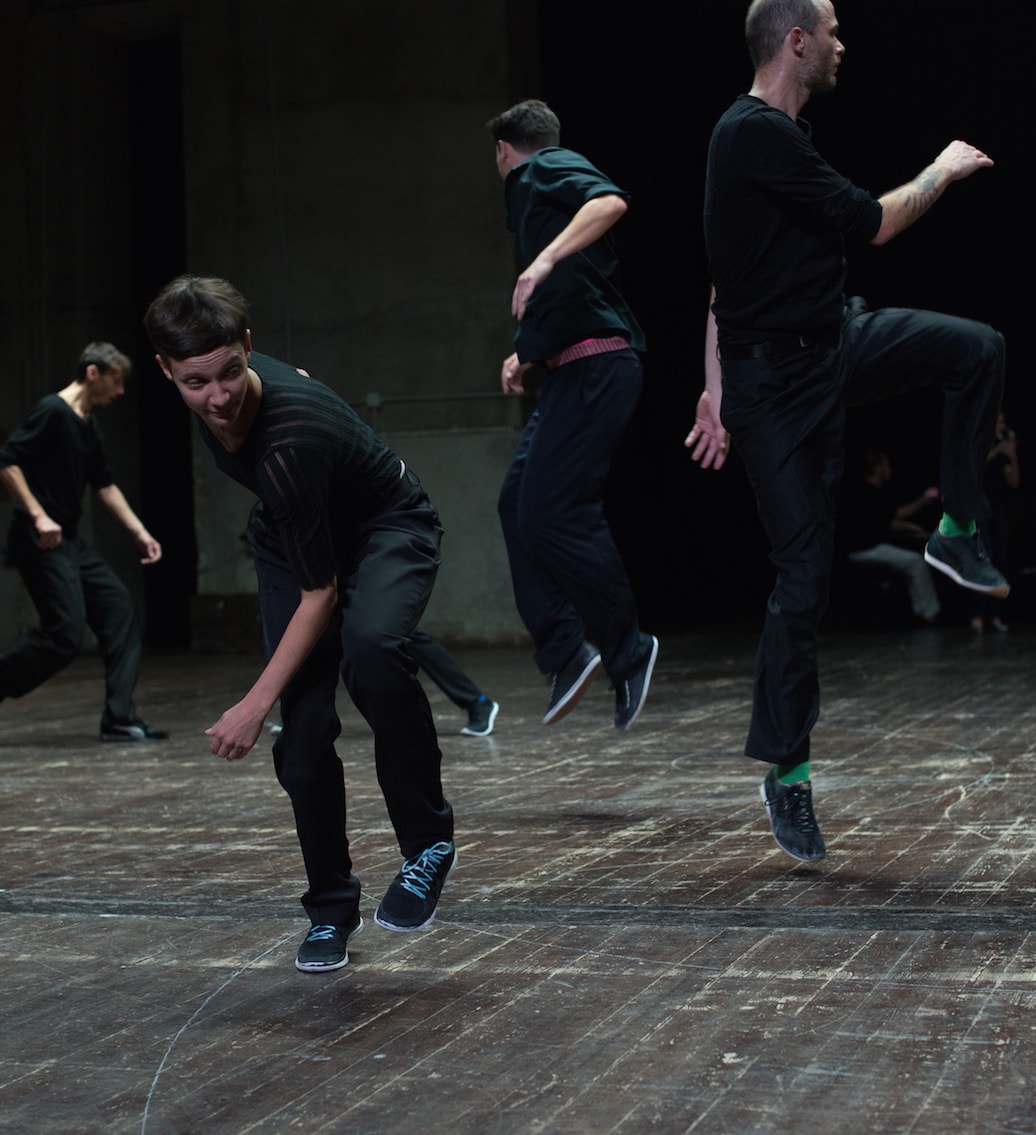
In Vortex Temporum Anne Teresa De Keersmaeker takes on the polyphony in Gérard Grisey’s eponymous masterpiece with a danced counterpoint for seven dancers. Probing the question: «How can you visualise polyphony by dancing it?». De Keersmaeker decided to stage an intricate intertwining of sound and movement. Each dancer is linked to one of the seven musicians, and colours his or her dancing with patterns of movement proper to the instrument. Both the dancers and musicians travel the stage following a pattern – a vortex – of swirling circles. As De Keersmaeker observes: «Time can be thought of as both linear and cyclical. That which we call “now” is, in fact, a permanent tipping point; a balancing act between memory and anticipation, leaning back and forth between the ghost image of the past and a desire towards the future».
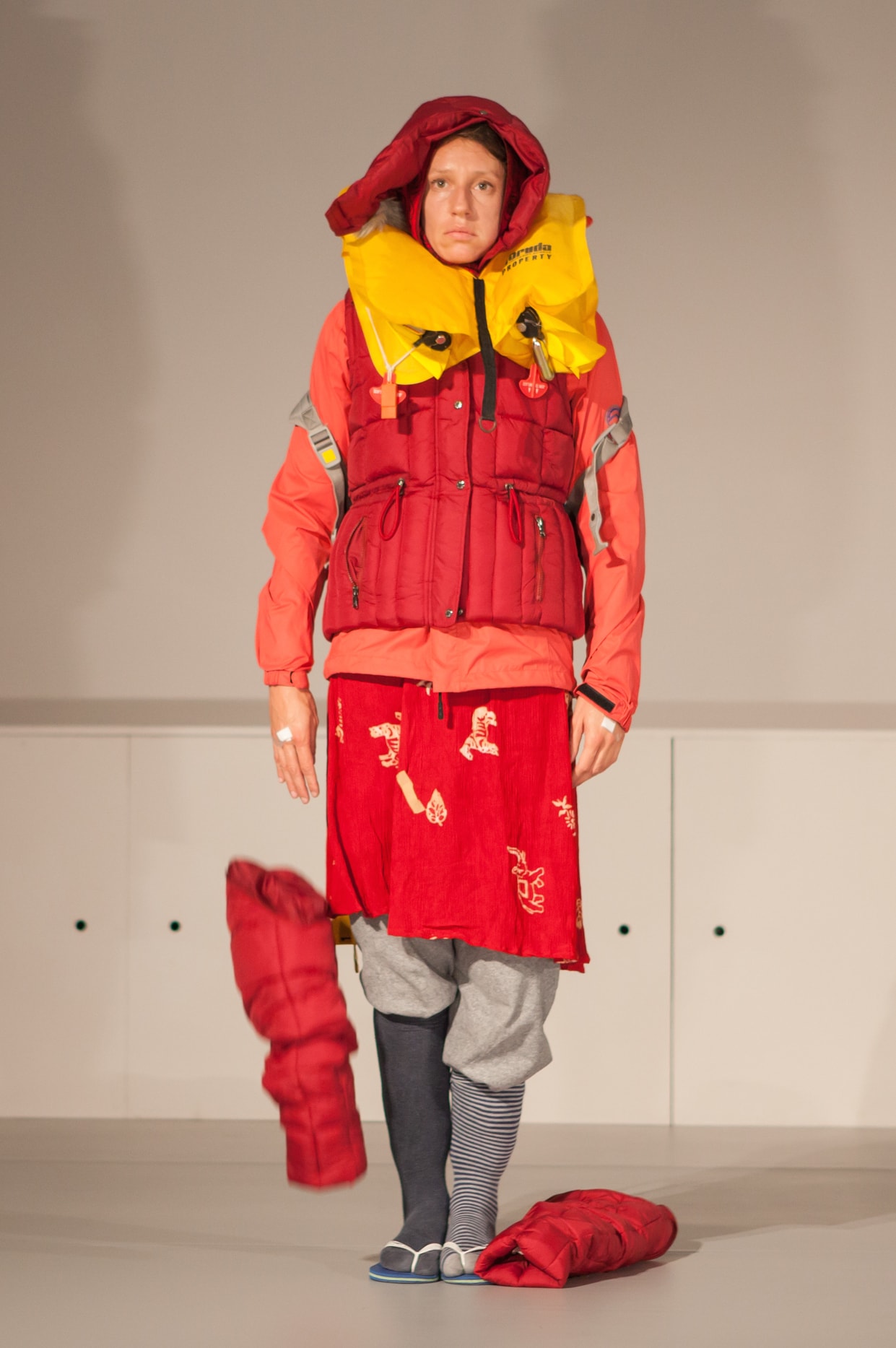
I often have to pack and unpack my backpack. To fill it with useful objects, which I will definitely use, that I can’t afford to forget, the indispensable ones; with objects I might need, because you never know; with objects I will only use once, the irreplaceable ones; then there are the objects that I forgot, that I did not remember I had left there, and that are still there, almost by accident. In my somewhat nomadic life I have a special fondness for my backpack. Every time it forces me to make an obligated choice. What I put in and what I leave out, what stays out is perhaps less important than what goes in, a filter between me and all the rest. In this new project, I develop a solo choreographic score arising from the urgency to create an intuitive relationship with my objects. How these objects can change me and determine the construction and deconstruction of my image, how the transformation can be endured and forced, determined by outside elements and free of any intent or will on my part, how can I disrupt the idea of possession, restoring the objects to their dynamic role as active agents? The backpack, like a turtle’s shell, hides me, it offers me protection, it’s heavy, it forces me to never let go of it. By leaving and finding those objects again, sometimes useful sometimes not, I allow myself to be transformed, to be inhabited by their colours, forms and functions, always with me in every circumstance, in my wandering, in every place.
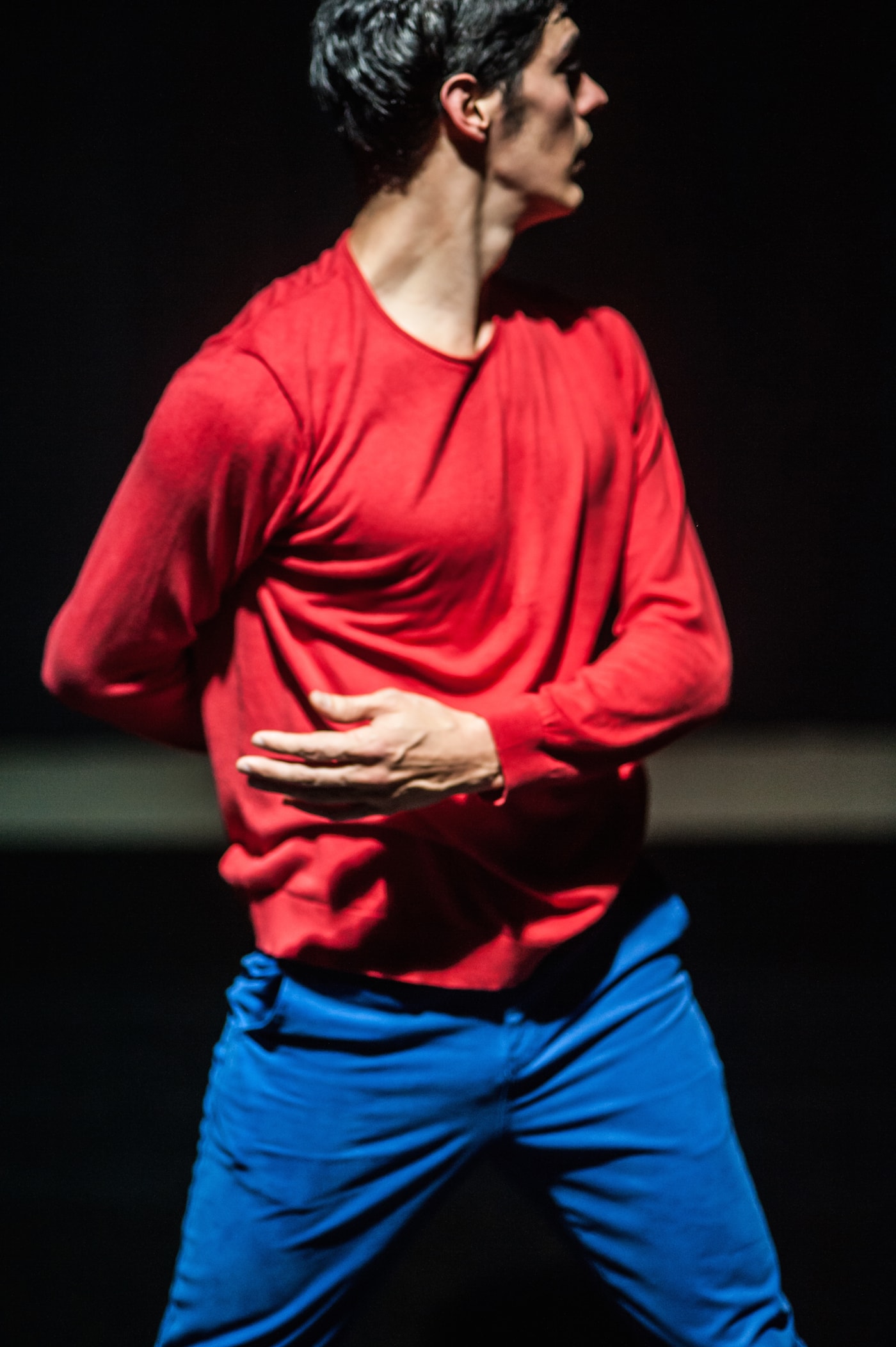
...a being racing into the future passes a being racing into the past, two footprints perpetually obliterating one another, toe to heel, heel to toe.
(Yeats, A Vision)
Gabriel Schenker’s Pulse Constellations departs from John McGuire’s electronic composition Pulse Music III, from 1978, a complex multi-layered piece born from an aural image of movements in space. The piece combines a variety of pulses, tempos, and melodies to form a sequence of 24 distinct but interrelated sections that fold into each other in abrupt, unexpected ways. The quality of the sounds, the fullness of the composition, and its constant, unsettling movement in space, brings about a stellar, cosmic quality to the work. In his Pulse Constellations, choreographer and dancer Gabriel Schenker deconstructs and reconstructs the complex web of pulse layers of the composition.
A kaleidoscope of rhythms and coordinations cross his body in overlapping rhythms. With his performance, Schenker explores the limits between the mathematical and the organic, the digital precision of electronic music and the analogue imprecision of a dance, the borders between the danceable and the audible. Pulse Constellations follows the compositional structures of Pulse Music III by breaking it down to smaller pieces, by following its flow, and by adding melodic and rhythmic lines through the shared aural and visual space.

dbddbb is an intricate and boisterous choreography driven by a simple yet uncompromising rule: every step must be followed by another. In this new creation by Daniel Linehan, five dancers are chanting and performing a “march”. Their march can be a military exercise, but also a political protest, a sport or a game; it can be a ritualistic incantation or a dance party. The performers don’t accompany their steps with words, songs or slogans but with dada-inspired chants. Their sounds and rhythms don’t give any information - instead they almost become a physical, dancing entity in the space. dbddbb examines the pleasures as well as the perils involved in the forces that bind a group. Instead of a classic unison, the choreography proposes a march of complex togetherness, of dynamic coordinations that leave space for the individual. The dancers move on the same beat, but at individual rhythms; move in the same direction but with individual gestures; move in the same tempo but with individual chants. How can we continually re-establish and re-invigorate our sense of togetherness even while our points in common keep shifting? Can we find ways of moving together without losing ourselves? Revelling in the pleasures of vocal expression, dbddbb suggests that it might be necessary to invent a new language in order to move from this step to the next.
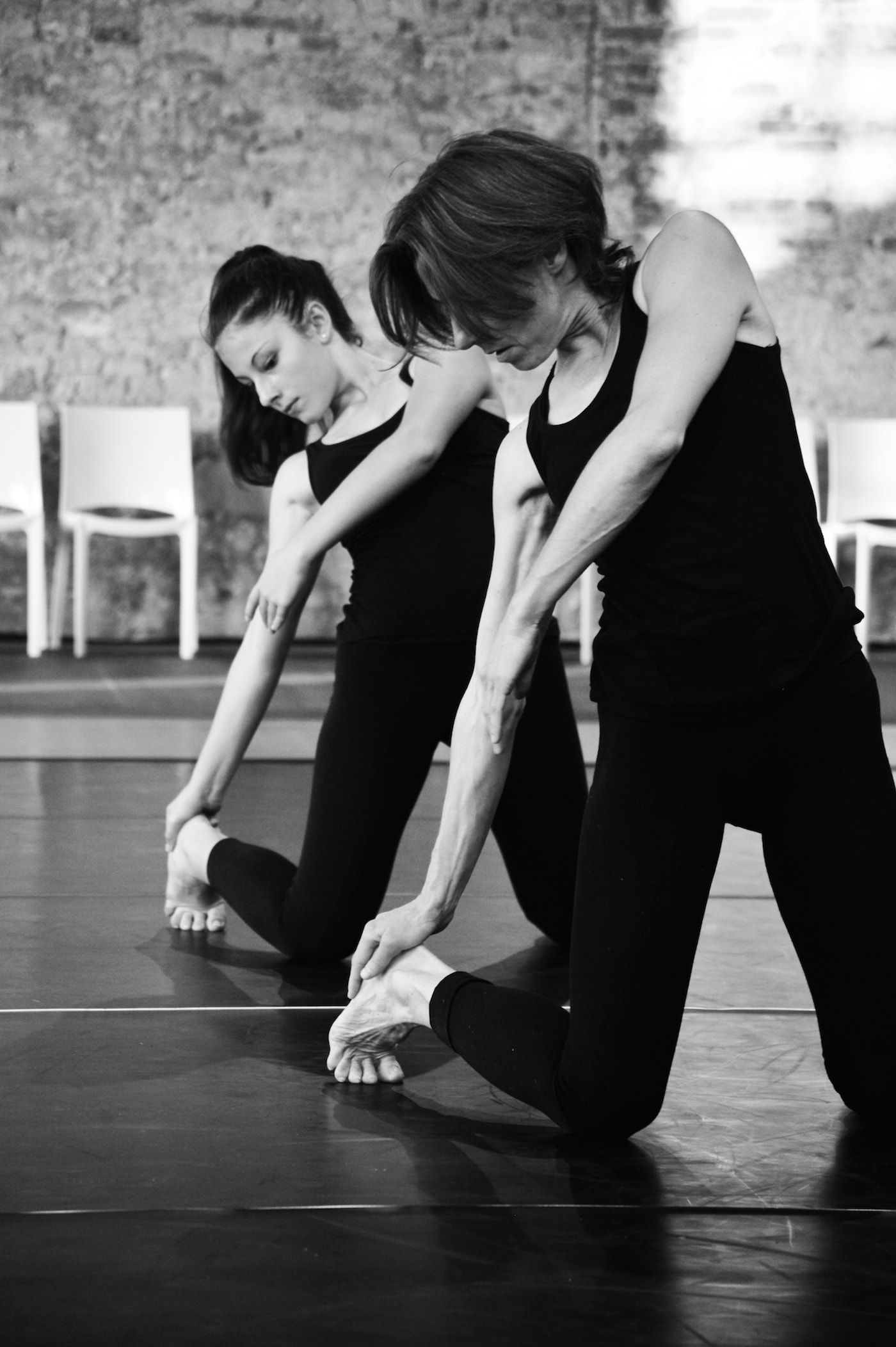
Black as a universal synthesis, as a symbol of mysterious, generative and complex power that embodies the intelligence of construction, that anticipates the phase of birth. A place of beginnings, a place of waiting, I imagine it as a cave that contains potency and germination. Here the passing of time is suspended, it occupies a space parallel to reality. Here our bodies reorganize an idea of origin and vicinity, of tension towards one another and towards the first instant. Black is a magnetic distance across time, like the perspectives of different ages: an interval of 31 years.
With the passing of time I have increasingly felt the need to limit and question my movement in space, to stay on the edge, to feel the giddiness of balance. To find a place and immediately look for another, to test gravity, the measure of things, freedom in space. This happens very concretely when I use objects and simple geometric forms, when I am able to constrain the body by placing it in relation to something defined. When I relate to people whose experience is different from mine, whose ages and approaches are different. I believe it all has to do with the search for an origin, an attempt to rediscover instinct or feel the moment of the beginning. With the need to shake off the awareness and to pay a different kind of attention to time and space, and perhaps advance «backwards».
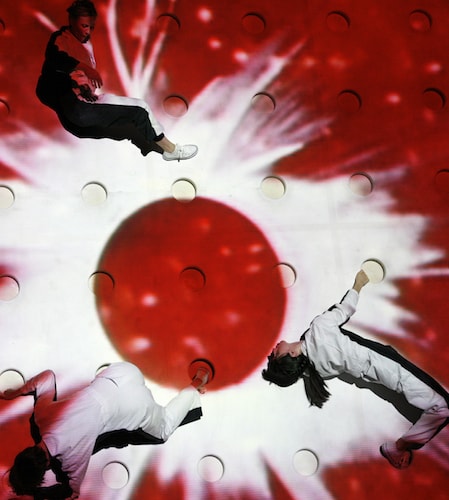
In Planes an aerial shot film made by Jud Yalkut is projected onto a wall with equidistant holes in it. Three dancers climb the surface of the wall in slow motion, giving the illusion of falling.
(Trisha Brown)
Planes is an exploration of the corollaries between psychic space and the psychical escape of consciousness beyond the Earths’ biosphere. Conceive of the theater as vertical tunnel in which the audience is suspended in planes of rows. The city as centralized magnetic center, whose momentum is perpendicular, becomes the escape valve for a continuous ascent, spanning the poetics of macro- and micro-cosm, culminating in the brief and rapid deceleration of re-entry.
(Jud Yalkut)
Opal Loop could be danced on the surface of the sun, it seems, without losing its brooding elegance.
(Jennifer Dunning, «The New York Times»)
Locus is a single phrase of movement, in which Trisha Brown has used a simple matrix of points, outside her body, towards which she orients or directs her movement.
Made in memory of Trisha Brown’s friend Michel Guy, For M.G.: The Movie is based on subconscious movement and on the bond between emotion and abstraction. Trisha Brown explains: «I wanted to slip dancers on and off the stage as they do in film, not to lumber in their great big two-legged bodies. I wanted mystery. Sleight of body».
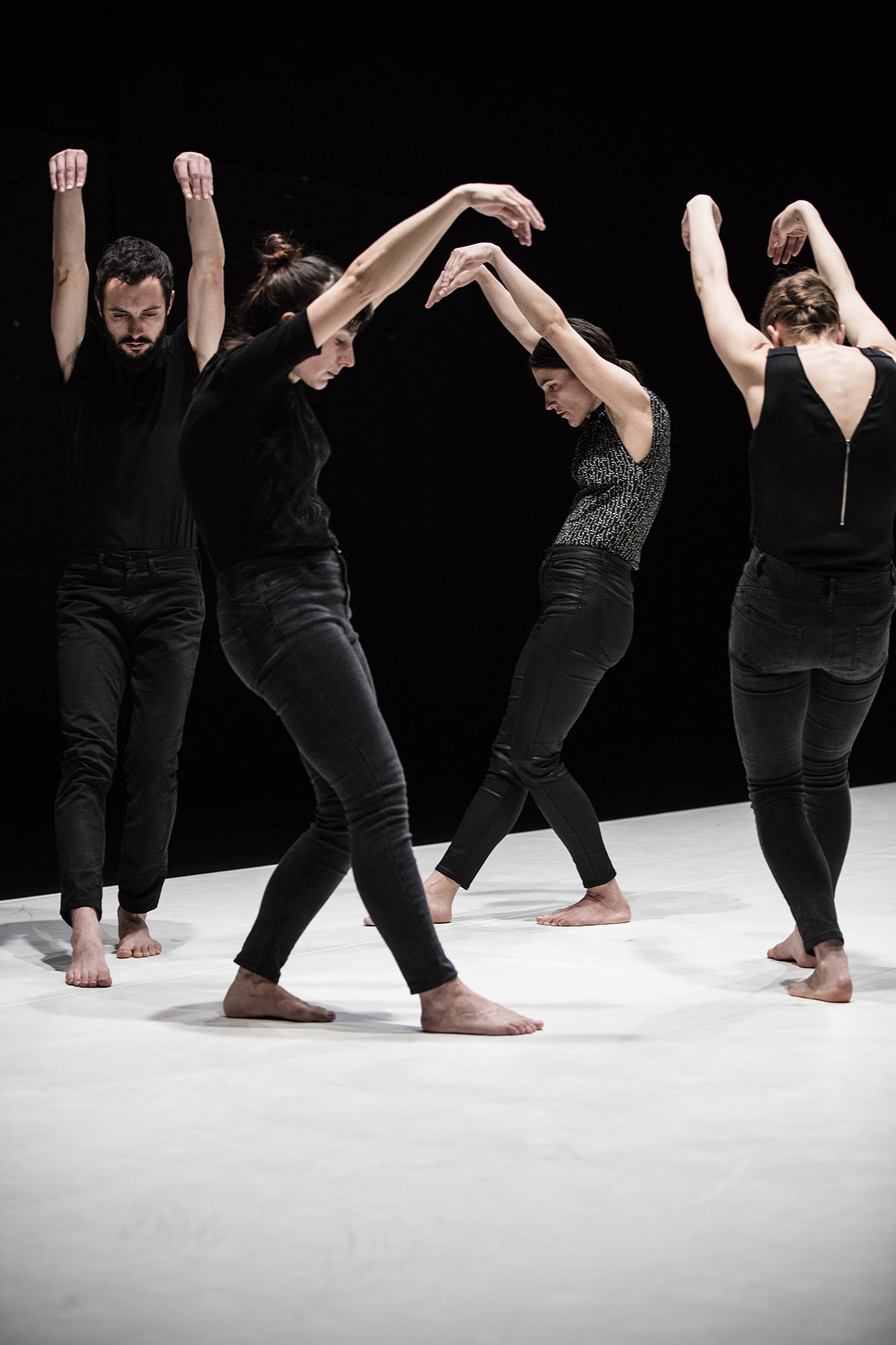
Emanuel Gat
Yasmine Hugonnet
Thomas Hauert
Three guest choreographers will conduct three experiences in creation in three specific spaces. In addition to the presentation of a performance with their own companies, the presence of the artists is conceived in the form of duration and transmission, of understanding and analysing indoor and outdoor spaces. For the section Agorà/Aperto_campi veneziani, with the dancers of the Biennale College they will create a diptych composed of a work to be presented in an indoor space and in the outdoor space of a Venetian campo, developing experimental practices within the organic dimension of the city.
Emanuel Gat Dance / Emanuel Gat / Awir Leon
Sunny
Emanuel Gat together with Awir Leon, producer, musician and performer, created SUNNY as a multi-layered event, juxtaposing a live musical concert with a vibrant choreographic exploration. An explosion of ideas, SUNNY is a flowing free-form merging new sounds with an in-depth questioning about contemporary choreographic possibilities.
Yasmine Hugonnet
La Ronde / Quatuor
A round dance with four bodies. Four dancers who link through reciprocal and reverting gestures. A round dance with faces, backs and movements spinning like a timeline on a vase. A round dance is the space that time needs to transform one dancer into the next. Each one unfurls into the next following a shared dance around a lapse of memory.
Thomas Hauert (CH) / ZOO inaudible
In this new group piece for six dancers, Thomas Hauert focuses on the notion of «interpretation». By deconstructing codes and cultural layers, inaudible offers a game between highbrow art and popular culture, between direct seduction and deceiving expectations that makes the choreographer’s language accessible yet unpredictable.
inaudible, several forms of interpretation function together and create the artistic experience. Interpretation as a way of executing a piece or a score: the performer’s interpretation.
Then the interpretation of the arranger who invents the orchestration based on the basic musical material – in the case of Concerto in F, the source is the version for two pianos written by Gershwin in the first stage of his creation of this work. Gershwin himself was to write the orchestration for a large orchestra and piano; the arranger Ferde Grofé (who had created the original orchestration for Rhapsody in Blue) wrote a version for a smaller orchestra in 1932.
Then there is the interpretation that guides the choreographer/director composing with all the dramaturgical elements; the interpretation given to situations by the dancers when they react to events on stage while improvising, but also interpretation as the meaning given to a sign, a sound or a gesture: the spectator’s interpretation.
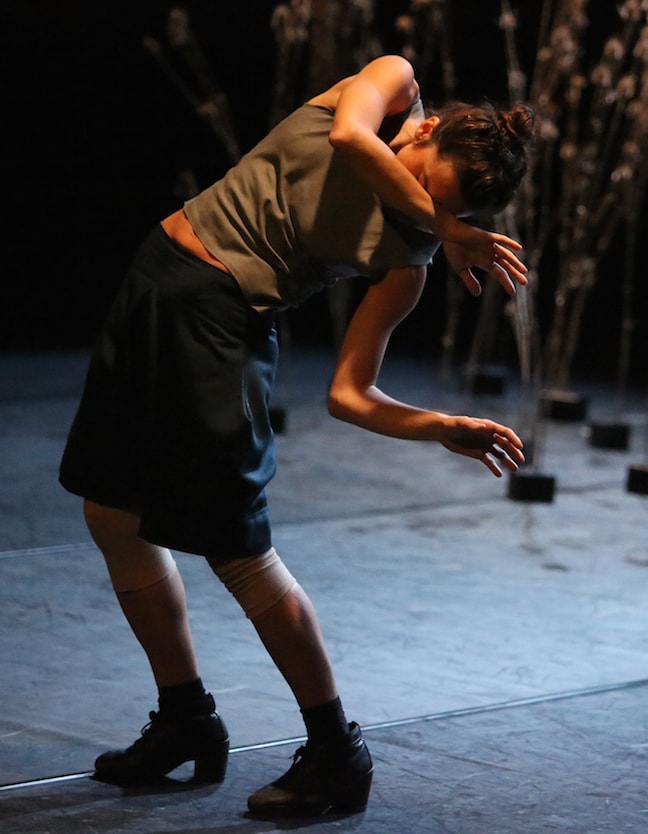
Nacera Belaza
Adriana Borriello
Isabelle Schad / Laurent Goldring
Annamaria Ajmone
Five choreographers present four diptychs each consisting of a creation presented with own company, and one with the dancers of the Biennale College – Dance, developing the practices of research and creation within an organic dimension of the city.
Nacera Belaza
La Traversée
Sur le fil
La Procession
La Traversée
What matters to me in this new project is to move the interrogation about the sacred memory of the body into other cultures. The central question that animates this search remains, in my mind, how to link choreographic writing such as mine to an ancestral dimension carried in the bodies, buried in the bodies?
Sur le fil
What allows the writing to endure and to reach beyond the stage performance is to be found within the risk each performer willingly takes. Its capacity to relentlessly summon a rigorous form, where the comprehensive rules of writing include their own infringement, until both body and mind give up and no longer represent a limit. This twofold exhortation gives way to a paradoxical experience, a blend of infinite submission and abandon.
La Procession
A group of spectators (a single body) will be brought to circulate inside a sensorial itinerary that will allow them to discover the place, the objects, the choreography that trace this itinerary. This will be a way to create sensitivity and openness in the spectator that will allow him to abstract himself from his usual functions, behaviour and perceptions. His personal body condition will give him an acute awareness of space, sounds, objects. The perception will thus be transformed, exasperated. It will also be important to integrate the object into this itinerary to divest it of its «material and anecdotic» aspect and in the same way to give it an oneiric dimension that diffuses and transmits its function and the imagery surrounding it.
Adriana Borriello
Col Corpo Capisco #2
La conoscenza della non conoscenza
Col Corpo Capisco is not just a title, but a statement, a manifesto, a way of being in the world. The focus of the modular project is the transmission from body to body that places the emphasis on “feeling” and generates forms of empathetic communication. Dance, the essence of the «useless» act that reflects upon itself, becomes a medium of knowledge of non-knowledge, wisdom of the body, of being there. The first movement, Col Corpo Capisco #1, is the original score that gathers the foundations of the practice and serves as a theme. Col Corpo Capisco #2 is the first variation generated by the «visit» of a fourth performer who, in addressing the principles and choreographic composition of the theme, opens to new questions and forces a re- generation and re-composition of the original choreographic-musical score. Here dance is both the act and the contemplation of it, the creative becomes receptive and vice-versa; here the body is elementary substance, space-time that is materialized and incarnated in visual form and sound, it is timbre and resonance that touches the Other and reveals the invisible, the inaudible, the unsayable.
La conoscenza della non conoscenza is based on an elementary choreographic score that reaches down to the poetic and educational foundations of the proposal – ontological body, musical body, anthropological body – and constitutes the beginning of a new creative process leading towards an unpredictable new form. The dialogue between text (existing score) and context (who, how, where, when) is an opportunity for re-generation. La conoscenza della non conoscenza is a practice/exercise in impermanence, the uniqueness of the act, the continuous present. All we can do is place our trust (in the body?) and accept the risk.
Isabelle Schad / Laurent Goldring
Der Bau
Collective Jumps
The intoxicating dance-theater work Der Bau, created by Berlin-based choreographer Isabelle Schad and French artist Laurent Goldring, is inspired by Franz Kafka’s unfinished novella of the same title. With a mix of lush, ferocious, and sometimes spare movement, performed nude, Schad uses an animal’s burrow as a metaphor for the human body. Kafka’s labyrinth – described as a space derived from the body, and yet still belonging to it – is suggested by a large and commanding sheet of fabric, which is beautifully manipulated to dramatically alter the visual and physical relationship between body and space.
Collective Jumps addresses the topics of collectivity and resistance, investigating the possible relationships between freedom and form with a group of performers. Can the creation of an infinite, unified, monstrous body possibly become a site of resistance?
Annamaria Ajmone
Tiny Extended
Imaginary Gardens with Real Toads in Them
In Tiny Extended I explore my body as an archives populated with personal and cultural memories, fantasies, invisible powers, distant echoes, sounds, smells, images. I discover and select traces of me, which I use to experience and build a space for dwelling. The processes of interior and exterior metamorphosis blend, mutually affecting the space in a continuous play of resonances. Tiny Extended explores the limit zones, where there is no real separation between the outer universe and the inner contents, because the Ego is never isolated from what surrounds it, but is defined on the basis of its relations and thanks to them learns to know. The idea of Tiny Extended arose from a research project that began in 2013 with filmmaker Maria Giovanna Cicciari, the purpose of which was to explore the relationship between the image in movement and dance (www.radura.it). The work was developed in a climate of total freedom, alternating indoor and outdoor work sessions. Tiny Extended reflects on the ways that human beings exist in the world as they dwell in space. Where dwelling means embracing, moving through, being, staying in things.
Imaginary Gardens with Real Toads in Them is inspired by studies of real and parallel botany. It will explore systems of interconnection with the purpose of creating an intimate but shared space and time.
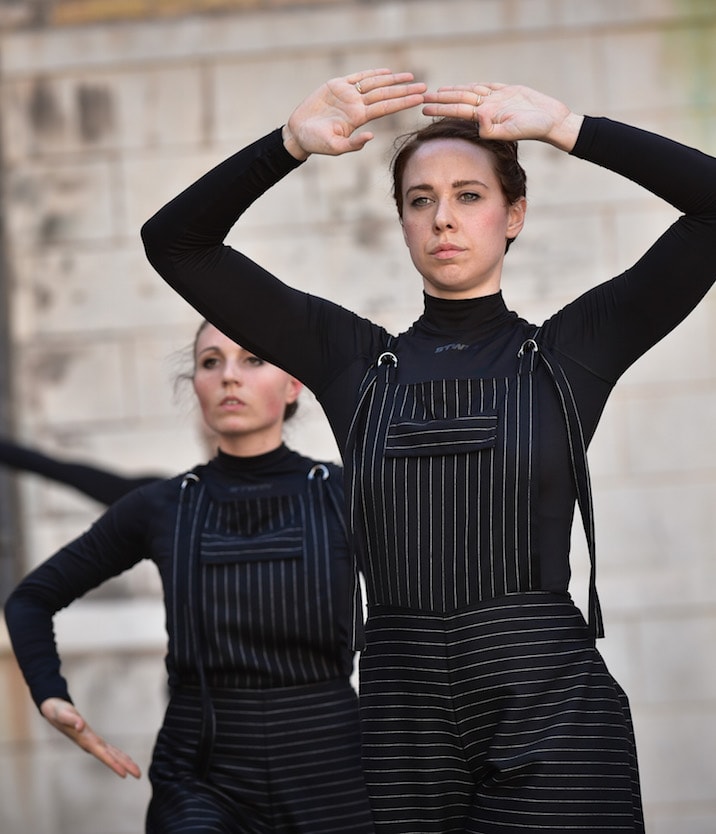
Emanuel Gat
Yasmine Hugonnet
Boris Charmatz
Sandy Williams / Rosas
Thomas Hauert
Claudia Castellucci
Virgilio Sieni
The Agorà project presents a cycle of original choreographic works created by the guest choreographers at the Festival and performed by the 120 dancers of the Biennale College – Dance, to explore assessments and variations in relation to the outdoors, to the margins and volumes in a selection of Venetian campi. Seven choreographers will elaborate a research project that will be performed before the public in an outdoor space. A true Festival within the Festival, offering a continuum of events organized according to a geography of campi and walking experiences for the audience.
Emanuel Gat
Venice
Venice is yet another experiment in accelerated choreographic processes, inherently linked to, and generated by, their immediate context (the time, the place and the dancers involved). Hence, an emerging system representing numerous ideas and inquiries, which is taking form ‘on the go’. A way to look at choreography not as something one makes, but rather as something that HAPPENS.
Yasmine Hugonnet
Unfolding Figures
The work is based on a practice of movement that considers all that is moving: attention, sensation, imagination, not only visible moves. It plays with: de-prioritizing the organization of the body / redistributing stillness and mobility, stability and instability / engaging in dance as a state of production, and at the same time of reception.
Working with the idea of Postures as containers (collecting resonances on many levels: sensorial, imaginary, symbolic...) inviting a deep engagement in physicality and attention.
Boris Charmatz / Olivia Grandville / Magali Caillet-Gajan
Levée des conflits
Levée des conflits is the final outcome of a workshop with dancers from Biennale College. During the workshop each dancer is caught in a movement pervious both to the dancer that precedes and to the one that follows, in order to create a choreography where every part can be seen simultaneously. Bodies replace one another continuously, so that if the structure swivels without end, the shape itself remains totally stable. It is a sculpture. The piece therefore is an essentially meditative one... It cannot exist without the bodies subtly activating it. This choreography irresistibly reminds me of the subjective definition of the Neutral according to Roland Barthes: the neutral as a desire for the suspension of conflicts. The project is at the same time minimal and totally beyond measure: minimal because the whole of the piece can be grasped at a single glance, beyond measure because the company is enormous and stirred by an infinity of breathing gestures.
Boris Charmatz
Sandy Williams / Rosas
My Walking Is My Dancing
My Walking Is My Dancing is the final outcome of a workshop with dancers from Biennale College. It is a mode of movement generation and analysis that has formed the basis for much of the work of Rosas in the past years. It serves as a way to question the boundaries between the pedestrian moments of everyday life and the virtuoso movements of the performer.
It also serves as a framework that can be used to evaluate and explore movement and choreography by creating a common vocabulary between all collaborators and serving as an essential shared base from which variation and change can be traced.
Along with the task of My Walking Is My Dancing, participants will investigate other core composition techniques employed by Anne Teresa De Keersmaeker and Rosas in the current repertory and experiment with their application in creation and performance.
Thomas Hauert
Tools for Dance Improvisations
Every joint in our body has its range of movement, there are countless possible combinations. The body contains a great practical knowledge far beyond what the mind is capable of processing, resulting in an ever-changing, fluid sense of orientation that can serve as a sensor for potential movement. Through (group) improvisation with one or more partners, exchanging information through touch, we will take advantage of this phenomenon to create forms, rhythms, and movement qualities more sophisticated than our minds could invent.
Claudia Castellucci
Verso la specie
The hegemony of the dance we propose is music not the body. We will not speak of expression of the body, but of uninterrupted physical presence, prepared and determined to address the time that is manifest in the music. The past must be dealt with when it has already converged into the present, and even the pause is a responsible moment of presence. The principal movement will be a concerted ambulation built on some of the canons inspired by the metrics of archaic Greek poetry and the essential movement of horses. Dance is a revelation of individual presence, which emerges from – and thanks to – choral movement.
Virgilio Sieni / Michele Rabbia
Danze sulla debolezza
The study will concentrate on transmission and resonances through an articular discourse of the body. An exploration of tactility between shared space and the place of the body. The process will also involve citizens and will include the use of objects to build dwellings.
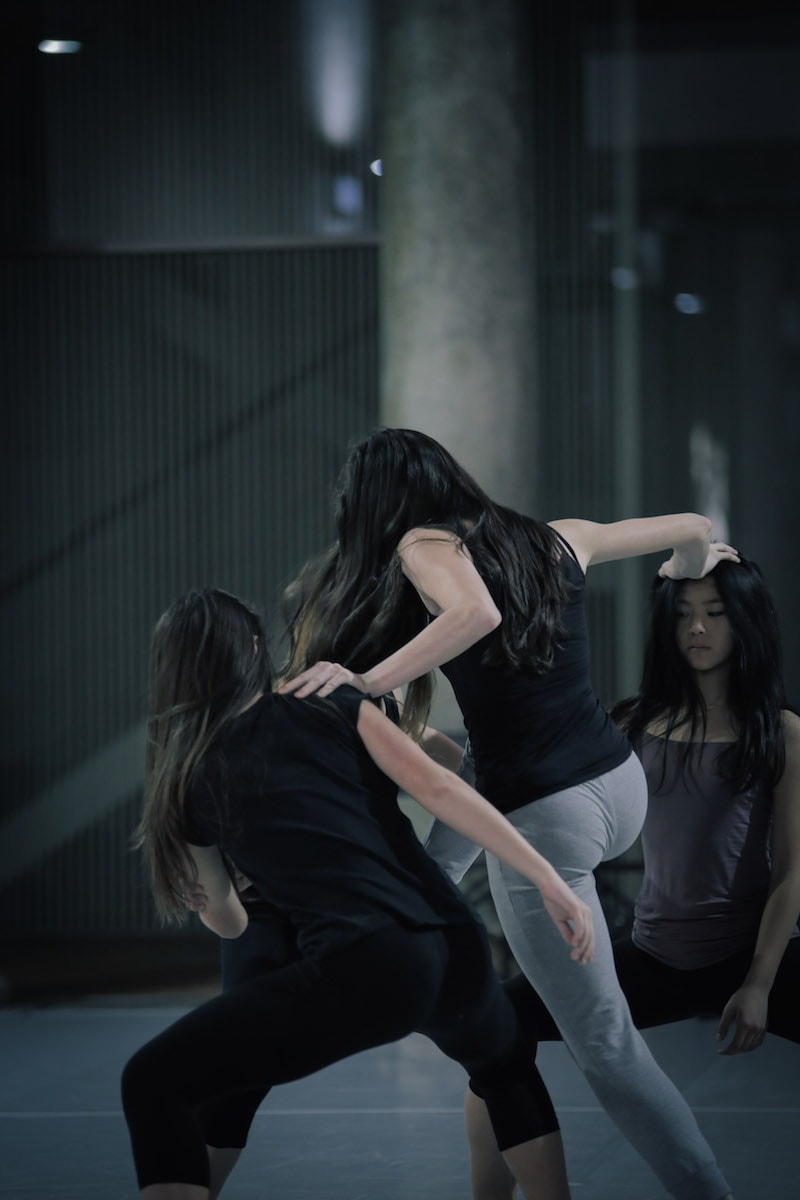
Marina Giovannini
Manfredi Perego
Chelo Zoppi
The Vita Nova project now in its fourth year proposes a method of transmission involving young dancers between the ages of 10 and 16. An innovative project, the endpoint for many experiences taking place across Italy, it has been developed over the past few years in various regions of Italy, generating a proliferation of choreographic and training experiences. The three chosen choreographers will work on a new creation with three groups of young dancers, selected this year in collaboration with the two Italian regions Marche and Tuscany.
Marina Giovannini / Manfredi Perego / Chelo Zoppi
Quattro #Venezia
Primitiva
Four
Quattro # Venezia – I return into what is what is in four directions and circularly, for an exercise that becomes meaning that may be read immediately in what is being shown. It is intriguing to limit movement in space, to test the measure of things, gravity, to stand on the edge, to feel the giddiness of balance. To find a place and immediately find another, to enter into simple geometric forms, to constrain the body by bringing it into relation with something definite and to constrain freedom just to know it exists.
Primitiva is a word that evokes a far away time, perhaps so far away that it can neither be imagined, tasted, experienced. Primitiva implies a perception in time that is beyond our comprehension. Our experience of time is infinitely absurd with respect to that of the earth, but so powerful as to strongly influence our life. Primitiva is not a choreographic route that addresses the issue of time however, but a choreographic exploration of what we still feel to be primitive in our body. I want to explore basic elements of perception in the body, of a primitive movement that can then place itself at the service of a choreographic exploration.
Four is the result of a training and creation experience that the four young female dancers have followed over these years. An experience that introduced them to the understanding of the body and the way it moves through the practices of the contemporary. Their bodies, still uncertain of becoming adult, display the fragility of the sign and the freshness of thought bared of any sense, if not that of dancing their own dream. In this piece dance obeys the body and the physical laws that rule them, displaying features of precious lightness.
Elisabetta Consonni
Cristina Pancini
Andrea Montesi
Adriano Cancellieri
A collection of traces, expressions, gestures, margins, details and spaces: a team, composed of an urban sociologist (Adriano Cancellieri), an architect (Andrea Montesi), an artist-diarist (Cristina Pancini) and the choreographer/dancer herself (Elisabetta Consonni), will explore a section of territory, and interpret its traces in a short cycle of dances, of shared experiences, of archives of details.
The symposium Ergonomica. Connecting dance and architecture in urban areas is organized by Connecting Cultures and Elisabetta Consonni
Enough space for the most tender of attentions is at the same time a workshop, a traveling performance built with the participants, and an installation in the Laboratorio delle Arti at Ca’ Giustinian. The choreographic, sociological, architectural and artistic components work together to structure a way of belonging to public space that prefers not to stand still but to dwell in the flows and the crossings and take care of the interstitial spaces. The process is open to dancers, artists, sociologists, architects, as well as professional walkers, walkers on the water, on burning coals, Charons, spirits that walk through walls, tourists and passers-by. In the room: a rolled-up logbook as long as the memory of the experience, bodies in motion (yours), traces of dialogues with and about space, devices that may be used to guide orientation, the experiences of a group in securing enough space for the most tender of attentions.
Spazio Ergonomico is a conference that inaugurates the European Ergonomica network built on the cooperation between nine European partners working in the fields of the performing arts and architecture. Ergonomica intends to promote the relationships between dance and architecture as an instrument of urban regeneration. The title of the project refers to the science of Ergonomics, which studies the interaction between the human body and built space. Dance, considered for its capacity to stimulate a conscience embodied in the space, is a potential instrument for urban regeneration and a way to activate a sense of belonging to both public and private space.